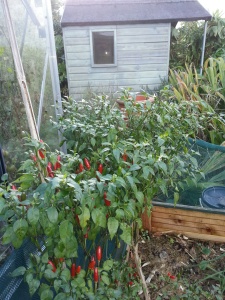I had set aside this morning to do a little bit of pruning on a handful of plants that I would like to over-winter. In my growing chillies book there is a section on keeping plants over the winter, what temperatures to keep them at, how to prune them and when. But it isn’t an exact science, and very dependent upon autumn temperatures, where you live and where you keep your plants.
Anyway, despite the fact that we are only 5 weeks away from Christmas, the plants I want to keep, which are still in a greenhouse, in south Devon, are all still healthy and don’t yet need any pruning. Having said that, the ones I am keeping are mostly ones that I know will do well, or that I know are worth investing a bit of time and warmth in. So I have a some aji plants, a nice big piri piri, and a whopping great moruga scorpion. There are a few others which have a bit of fruit to ripen, but things like jalapeno, most of my habaneros, pimiento de padron and a few others have mostly been consigned to the compost bin.
So my thoughts turned to which plants would die first if I left them as they are. Which are the most frost tolerant? And some people might be interested in an experiment we conducted at the chilli farm many years ago. With the help of the weather we achieved some fairly accurate and interesting results. In a polytunnel containing 100 varieties we didn’t do the usual autumn cleanup, which is the way it should be done, good garden hygiene, stop the spread of disease, bla bla bla; instead we left the plants in situ, and while the temperature dropped over successive days we observed the results. This was the first cold snap of the year, so to begin with all the plants still had most of their leaves.
As the temperature inside the tunnel dropped towards freezing the first plants to succumb were the tropical ones, Capsicum chinense the habaneros and scotch bonnets, they will lose all their leaves in a single night at 1 or 2°c.
The next night the temperature dropped lower, and hit zero for the first time. At this point the ones to go are the bigger Capsicum annuum big peppers and jalapenos, especially the newer more highly bred ones.
Another day went by and overnight the temperature had reached -1°c. Now looking along the beds it was really evident which ones were survivors and which ones had suffered, but the leafless plants were interspersed with quite a few that still retained their leaves. These were mostly the Capsicum baccatum, tougher leaves and stems, originating from Andean areas where frost tolerance would be an advantage. But also the piri piri, tabasco, and strangely the Prairie Fire were still lookiing good, so the Capsicum frutescens display a lot of frost hardiness too.
Yet another day, and another degree or two of frost, and the only survivor was the tepin, a scrubby bunch of twigs, tiny tough leaves, and a very poor fruiter, but this truly wild chilli out-lived the rest; in fact this very plant lived on for four more years, until a very cold winter brought temperatures of -10°c, and that was the end of it.
So what is to be learned from this? Whatever the ‘rules’ about plant pruning and overwinter temperatures there will always be exceptions. My favourite is the piri piri, always the most loved chillies in my collection. I have said this before, but my mother has the ‘mother plant’ it is the only one she keeps now, so the seed never crosses with anything else, and I always kick off more than I need every spring. There are a lot of varieties under the piri piri banner; this is a Portuguese one, from an old ladies garden, and about midsized as they go, up to about an inch long, and they are solid bullets.
This picture of Piri Piri plants was taken on 12th November. It sits in a fairly sheltered south facing raised bed, which most importantly gives it good drainage so its roots aren’t sitting in claggy wet soil. The mild autumn temperatures this year do the rest, and it still flourishes albeit slowly, with ripe fruit, new fruit, and flowers.
This plant is the same variety, but inside a greenhouse, it is still going great guns, and might even survive the whole winter at this rate.
I’m always interested to know what the real survivors are in the chilli world, so if you have any anecdotes or experiences, post them underneath for others to see.



Nice to know that there are some Portuguese piripiris alive in Devon. I brought some piripiris a few years ago and planted 4 seeds in pots here in northern Sweden and 2 are still quite alive and giving fruits every year but I have to keep them indoors during the winter. Now it is time to put them outside and wait for some “red things” to appear!
LikeLike
I think they are the best chillies for keeping over winter, and they are more tolerant of cold than others too. I’m glad to hear they are going strong in northern Sweden!
LikeLike
Pingback: Overwintering Chilli Plants – Some practical examples | Chilli Books Blog